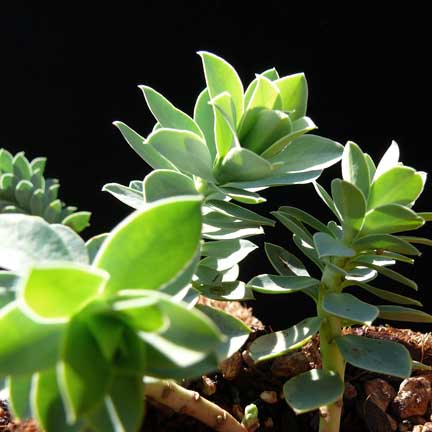Euphorbia
Pot Cultivation
The hardy kinds of Euphorbia are easily cultivated outdoors in ordinary soil. The different kinds for outdoor use are mentioned below in the section on varieties. The kinds that need to be grown in a greenhouse can be grown outdoors only in warm, dry climates such as southern California. Most of those grown in the greenhouse are the succulent plants. These plants need a sunny area with good ventilation and a minimum temperature of 50-55 degrees. Loamy soil with pieces of sandstone and brick rubble mixed in for adequate drainage should be used. A moderate amount of water is needed in the spring and summer, but throughout the fall and winter, less water is given. Poinsettias require much different care than the succulent kinds of Euphorbia. Poinsettias need an area free of drafts with a minimum temperature of 60 degrees. They are easily damaged by spraying them with insecticides. They require short days and long dark nights to bloom. Their soil should consist of three parts fibrous loam, and one part of equal amounts of dried cow manure, leaf mold and sand. When the plants are well established in their pots, the greenhouse should be ventilated more freely and the atmosphere should be kept drier during the early part of the growing season. Weekly doses of diluted liquid fertilizer should be applied until the bracts are well developed and the yellow flowers begin to open. The Scarlet Plume, as mentioned above in the descriptions, needs similar care to the Poinsettia. It thrives in a warm, humid atmosphere with good light. It won' t tolerate over or under watering, drafts, or disturbance of its roots. In their stages of early growth, the young plants should be pinched to encourage branching.Propagation
Poinsettias: After they have finished flowering, they should be partially cut back and kept in a dry atmosphere with 50- to 55-degree temperatures for several weeks. In May they should be pruned back within 6-8 inches of the soil and started into growth again by being watered and kept in a warm, sunny greenhouse. When the new shoots are 4 inches long, they can be inserted in a propagating frame in a hothouse with a minimum temperature of 65-70 degrees. As soon as they have formed roots, they can be potted and placed on a greenhouse bench in a minimum temperature of 60 degrees. They are repotted as needed until they are in pots with 6-7 inch diameters.
Hardy, outdoor kinds: Seeds may be sown outside in the springtime. Seeds for E. marginata and E. heterophylla, (Snow-on-the-Mountain and Mexican Fire Plant, respectively) should be planted where they are to remain and bloom, because they can't handle root disturbance and they do not transplant well. The seedlings should be thinned out, 9 to 12 inches.
Greenhouse kinds: Cuttings can be used to increase these plants, but make sure to let the succulent types dry out a bit before inserting them into sand.
 |
| E. Myrsinites |
VARIETIES
- Hardy, outdoor kinds:
E. Cyparissias, the Cypress Spurge, (Spreads rapidly and may become a problem weed if not carefully located and controlled. P, 1 ft.);
E. corollata, the Flowering Spurge, (P, 3 ft.);
E. Myrsinites, (P);
E. epithymoides, (P, 1 ft.);
E. marginata, Snow-on-the-Mountain, (A, 18 in.);
E. heterophylla, Mexican Fire Plant, (A).
- Greenhouse kinds:
Euphorbia pulcherrima, Poinsettia, (bush);
Euphorbia fulgens (E. jacquinaeflora), the Scarlet Plume (bush);
E. splendens, Crown of Thorns (S, climbing shrub);
E. splendens bojeri (S);
E. splendens Hislopii (S);
E. splendens prostrata (the most common variety of E. splendens, S);
E. Tirucallii, Milkbush (sm. tree or lg. bush);
E. meloformis, Melon Spurge (S);
E. antisyphilitica (the Candelilla, which produces a wax used commercially, S, shrub, about 3 ft.);
E. canariensis (S, tree or shrub about 20 ft.);
E. Caput-Medusae, Medusa's Head (S);
E. grandicornis (S, shrubby, 3 ft.);
E. grandidens (S, 30 ft.);
E. lactea (S, sm. tree or shrub);
E. neriifolia (S, tree or shrub);
E. obesa (S);
E. pentagona (S, 10 ft., shrubby);
E. Pseudocactus (S, shrub);
E. Susanniae (S);
E. tithymaloides (S, 6 ft., shrubby).




